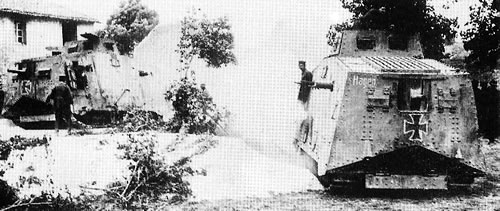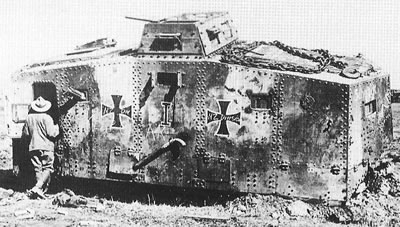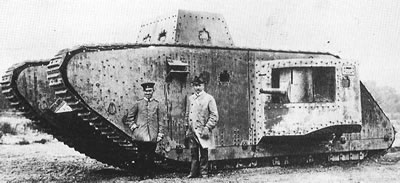The idea of armored vehicles wasn’t new to the Germans, German and Austrian engineers had in fact tinkered with armoring vehicles before the First World War but they’d had a hard time convincing higher authorities that they were useful.
Indeed, it wasn’t until the British attacked with tanks at Flers that the German authorities realized that they were wrong to dismiss these new machines. So, in October 1916, the German High Command rallied and put into action a committee to formulate plans for building German armored vehicles. The new committee had the codename A7V, and they quickly set about resurrecting the forgotten plans from before the war, aiming to build a massive 550 ton ‘armored land cruiser’. However, this idea never got very far and the Germans, like the French, initially turned their attention to road rollers and tractors which, as the French and British had learned, were not much use in trials.
The first German armored vehicle with tracks was designed by an engineer called Joseph Vollmer in 1917. He adapted a Bremer Marien Wagen, an early form of haulage truck with tracks, and fitted it with a steel body. However, like so many others before it, this proved unsuccessful in trials and only one prototype was ever made. So, like the British and the French, the Germans turned to American tractors, this time a Holt, like the French, only built in Hungary under license instead of the States.
 Joseph Vollmer had similar ideas to the British Tritton and Wilson when he lengthened the chassis and also made a longer version of the Holt tractor tracts to fit around the increased length of the vehicle. The modified Holt chassis was fitted with a full-scale model of the superstructure in April 1917. This became the prototype for Germany’s first tank and the A7V Sturmpanzerwagen, tested a month later, was accepted as the final model for production. This tank was box-like and its weapons were a 57 mm gun and six Maxim machineguns. The power-plant was two Daimler 100 hp engines and the whole thing weighed 33 tons. Perhaps the most staggering statistic for this tank, though, was that it ‘needed’ a crew of eighteen!
Joseph Vollmer had similar ideas to the British Tritton and Wilson when he lengthened the chassis and also made a longer version of the Holt tractor tracts to fit around the increased length of the vehicle. The modified Holt chassis was fitted with a full-scale model of the superstructure in April 1917. This became the prototype for Germany’s first tank and the A7V Sturmpanzerwagen, tested a month later, was accepted as the final model for production. This tank was box-like and its weapons were a 57 mm gun and six Maxim machineguns. The power-plant was two Daimler 100 hp engines and the whole thing weighed 33 tons. Perhaps the most staggering statistic for this tank, though, was that it ‘needed’ a crew of eighteen!
 German tank production crawled at a snail’s pace, so it wasn’t until March 21st 1918, with the War nearing its end, that they first brought a tank into battle when five A7V’s and some captured British Mark IV Tanks overran allied trenches at St Quentin, killing or capturing all the defenders.
German tank production crawled at a snail’s pace, so it wasn’t until March 21st 1918, with the War nearing its end, that they first brought a tank into battle when five A7V’s and some captured British Mark IV Tanks overran allied trenches at St Quentin, killing or capturing all the defenders.
Around fifteen German tanks fought against British Mark IV Tanks on April 24 1918 near Villers Bretonneux in the World’s first ever tank battle. Two of the British Mark IV female tanks were badly damaged, but the British finally drove off the German A7V’s at the end of the battle.
 In some ways the A7V was a better tank than the British Mark IV, it had two engines which gave it more power and a top speed of 8 mph (12km/h) and was protected by 30 mm (1 3/16 inch) armor. In other ways, however, it was inferior: its high center of gravity made it somewhat unstable over rough terrain and it could only traverse trenches under 6 feet (1.82 meters) across. The Germans did not have a lot of confidence in their own tanks, only about 20 A7V’s were built, and they preferred to use captured Mark IV’s. In fact the German army was so enamored with the British Mark IV tank that the High Command ordered a German tank to be built based on the Mark IV design, which gave birth to the A7V/U. It had all-round tracks like the British machine, but kept all the internal components of the old A7V. Still, only a prototype was ever built.
In some ways the A7V was a better tank than the British Mark IV, it had two engines which gave it more power and a top speed of 8 mph (12km/h) and was protected by 30 mm (1 3/16 inch) armor. In other ways, however, it was inferior: its high center of gravity made it somewhat unstable over rough terrain and it could only traverse trenches under 6 feet (1.82 meters) across. The Germans did not have a lot of confidence in their own tanks, only about 20 A7V’s were built, and they preferred to use captured Mark IV’s. In fact the German army was so enamored with the British Mark IV tank that the High Command ordered a German tank to be built based on the Mark IV design, which gave birth to the A7V/U. It had all-round tracks like the British machine, but kept all the internal components of the old A7V. Still, only a prototype was ever built.
So, the cumbersome A7V was the only German tank to see service during World War I, work on a massive 100-ton K-Wagen and the LK series of light tanks was halted at the Armistice, and the Germans did not build another active tank until the Panzer I in 1933. However, despite their slow start, it was the Germans that, after this point, would redefine the tank and its role in mechanized land warfare.